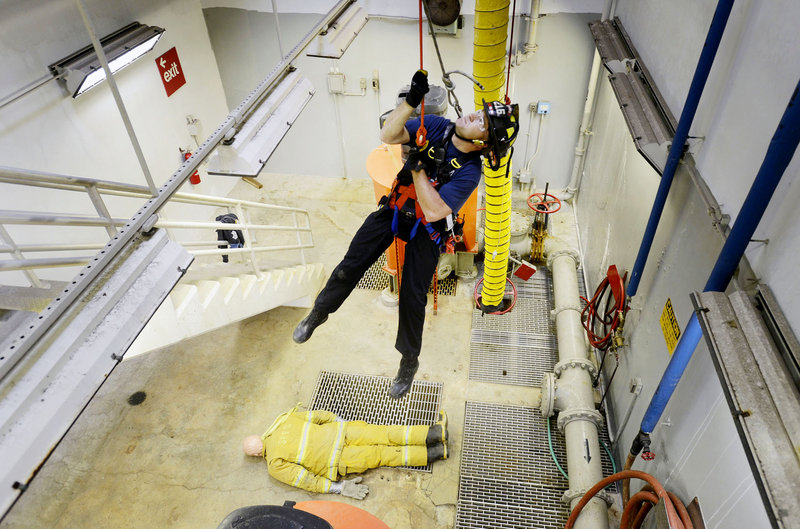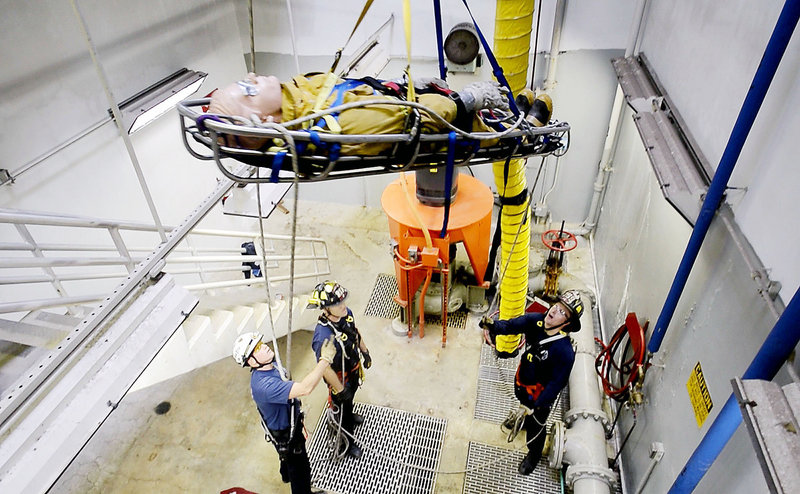PORTLAND – Firefighter David Nichols made sure his “victim” was secured into a vinyl sling and called to firefighters two stories above to begin hoisting.
The safety dummy, playing the victim, and the orange pad rose to the opening, with Nichols holding a line to keep it from swinging into the wall or getting tangled in other ropes.
Meanwhile, firefighters on the floor above used a series of blocks and tackle to ease the 200-pound weight out of the hole to safety.
The exercise, conducted Monday at a sewage pump station off Baxter Boulevard, was the final part of four days of training for Portland firefighters on how to rescue people from septic tanks, manholes and other confined spaces.
Members of Rescue 1, the city’s heavy rescue apparatus, trained firefighters from other companies how to conduct the technical rescues.
“We immediately start air monitoring, so we can get our air samples,” said Lt. Gene Cote, who helped to oversee Monday’s training, describing the initial stages of a confined-space rescue. “As soon as we get air monitoring done, we start ventilation and then we do our rigging so we can start lowering our guys into the hole.”
The federal Occupational Safety and Health Administration requires businesses whose workers operate around confined spaces to have access to a safety team. The business can put together its own team, hire a contractor or develop a memorandum of understanding with the local fire department to serve in that capacity, Cote said.
In Portland, businesses such as ecomaine, the regional waste-to-energy cooperative, have that requirement because workers could get injured inside hard-to-reach spaces, said city spokeswoman Nicole Clegg.
The importance of doing such rescues properly was borne out a year ago, when two workers from a company from Monmouth died in Kennebunkport while working in a sewage holding tank. The two were overcome by sewer gases.
Before firefighters go into a confined space, Cote said, they lower a long tube that samples the air to make sure it’s breathable. Even if it is, crews lower a large orange hose that blows fresh, cool air into the area. If the opening is too tight for a firefighter to wear an air tank, Cote said, they have to have air fed through a hose to their mask.
Staff Writer David Hench can be contacted at 791-6327 or at: dhench@pressherald.com
Send questions/comments to the editors.




Success. Please wait for the page to reload. If the page does not reload within 5 seconds, please refresh the page.
Enter your email and password to access comments.
Hi, to comment on stories you must . This profile is in addition to your subscription and website login.
Already have a commenting profile? .
Invalid username/password.
Please check your email to confirm and complete your registration.
Only subscribers are eligible to post comments. Please subscribe or login first for digital access. Here’s why.
Use the form below to reset your password. When you've submitted your account email, we will send an email with a reset code.